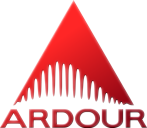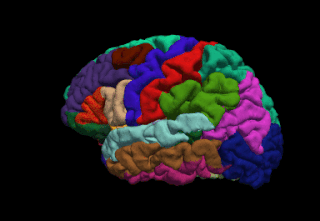Transcription refers to the process of converting sounds into letters or musical notes, or producing a copy of something in another medium, including:

Ardour is a hard disk recorder and digital audio workstation application that runs on Linux, macOS, FreeBSD and Microsoft Windows. Its primary author is Paul Davis, who was also responsible for the JACK Audio Connection Kit. It is intended as a digital audio workstation suitable for professional use.

FL Studio is a digital audio workstation (DAW) developed by the Belgian company Image-Line. It features a graphical user interface with a pattern-based music sequencer. The program is available in four different editions for Microsoft Windows and macOS.

A(DAW ) is an or used for recording, editing and producing audio files. DAWs come in a wide variety of configurations from a single software program on a laptop, to an integrated stand-alone unit, all the way to a highly complex configuration of numerous components controlled by a central computer. Regardless of configuration, modern DAWs have a central interface that allows the user to alter and mix multiple recordings and tracks into a final produced piece.

Rosegarden is a free software digital audio workstation program developed for Linux with ALSA, JACK and Qt4. It acts as an audio and MIDI sequencer, scorewriter and musical composition and editing tool. It is intended to be a free and alternative to such applications as Cubase.

Audio editing software is any software or computer program which allows editing and generating audio data. Audio editing software can be implemented completely or partly as a library, as a computer application, as a web application, or as a loadable kernel module. Wave editors are digital audio editors. There are many sources of software available to perform this function. Most can edit music, apply effects and filters, and adjust stereo channels.

OpenAL is a cross-platform audio application programming interface (API). It is designed for efficient rendering of multichannel three-dimensional positional audio. Its API style and conventions deliberately resemble those of OpenGL. OpenAL is an environmental 3D audio library, which can add realism to a game by simulating attenuation, the Doppler effect, and material densities.
The Environmental Audio Extensions are a number of digital signal processing presets for audio, present in Creative Technology Sound Blaster sound cards starting with the Sound Blaster Live and the Creative NOMAD/Creative ZEN product lines. Due to the release of Windows Vista in 2007, which deprecated the DirectSound3D API that EAX was based on, Creative discouraged EAX implementation in favour of its OpenAL-based EFX equivalent – though at that point relatively few games used the API.

Houdini is a 3D animation software application developed by Toronto-based SideFX, who adapted it from the PRISMS suite of procedural generation software tools.
Disposable Soft Synth Interface (DSSI) is a virtual instrument plugin architecture for use by music sequencer applications. It was designed for applications running under Linux, although there is nothing specific to Linux in the interface itself. It is distributed under the terms of a combination of LGPL-2.1-or-later and some BSD licenses, all of which are free software licences.

FreeSurfer is a brain imaging software package originally developed by Bruce Fischl, Anders Dale, Martin Sereno, and Doug Greve. Development and maintenance of FreeSurfer is now the primary responsibility of the Laboratory for Computational Neuroimaging at the Athinoula A. Martinos Center for Biomedical Imaging. FreeSurfer contains a set of programs with a common focus of analyzing magnetic resonance imaging (MRI) scans of brain tissue. It is an important tool in functional brain mapping and contains tools to conduct both volume based and surface based analysis. FreeSurfer includes tools for the reconstruction of topologically correct and geometrically accurate models of both the gray/white and pial surfaces, for measuring cortical thickness, surface area and folding, and for computing inter-subject registration based on the pattern of cortical folds.

Gnome Wave Cleaner (GWC) is a digital audio editor application. The graphical user interface for the editor has been produced employing GTK+ for the GUI widgets. Its primary author is Jeff Welty.

WaveLab is a digital audio editor and recording computer software application for Windows and macOS, created by Steinberg. WaveLab was started in 1995 and it is mainly the work of one programmer, Philippe Goutier.

A dictation machine is a sound recording device most commonly used to record speech for playback or to be typed into print. It includes digital voice recorders and tape recorder.

Logic Studio is a discontinued professional music production suite by Apple Inc. The first version of Logic Studio was unveiled on September 12, 2007. It claims to be the largest collection of modeled instruments, sampler instruments, effect plug-ins, and audio loops ever put in a single application.

Making Waves (MW) is computer software designed to produce professional quality audio from basic Windows multimedia PCs. This application was among the first of the 16-bit digital sequencers that evolved from the MS-DOS WAV trackers of the Eighties to become the digital audio workstation software available today including Steinberg Cubase, Pro Tools and ACID Pro. Making Waves enabled a small community of independent artists to use existing hardware to record, sample, mix and render their own original work creating professional-quality audio with a modest investment of less than $100. This same dynamic user community played a significant role in the application's development, suggesting program revisions and performing extensive beta testing. These users were all organized and mentored by Stephen John Steele, the original programmer and developer of Making Waves as well as a founding director of Perceptive Solutions, Spacehead Systems and Making Waves Software Limited.
WavePad Audio Editor Software is a multi-platform, digital audio editor and recorder. It supports VST and integrates a stock audio library.










